The Dohány Street Synagogue in Budapest stands as a testament to the rich cultural heritage of Hungarian Jewry. This magnificent structure, the largest Jewish temple in Europe, houses the acclaimed Hungarian Jewish Museum. Visitors can explore the synagogue’s stunning Orientalist and Hungarian Romantic architectural elements, from the intricate 1850s details to the ornately carved wooden pulpit. But beneath the synagogue’s breathtaking beauty lies a complex and often harrowing history, one that the museum’s exhibits seek to chronicle in depth. What stories await those who step through the synagogue’s doors?
Key Points
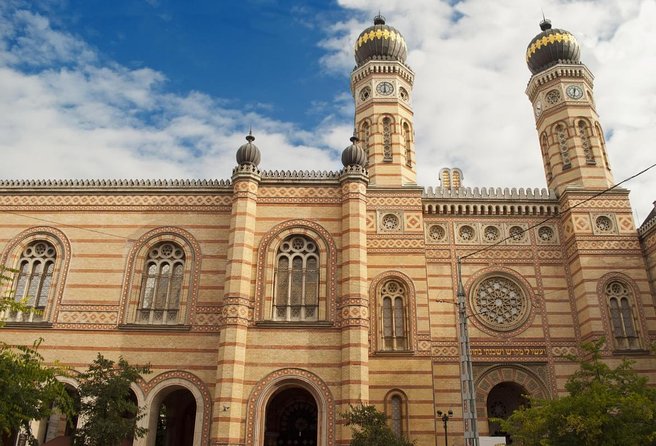
- The Dohány Street Synagogue is the largest synagogue in Europe and houses the Hungarian Jewish Museum, showcasing the rich history and culture of Hungarian Jewry.
- The synagogue’s architectural design blends Orientalist and Hungarian Romantic elements, featuring intricate 1850s details, ornate wooden pulpits, Moorish-style domes, and stunning stained-glass windows.
- Hungarian Jewry has a long and complex history, from periods of economic and cultural prosperity to waves of antisemitism and persecution, culminating in the devastating impact of the Holocaust.
- The synagogue and museum provide poignant memorials and educational exhibits chronicling the persecution, deportation, and murder of Hungary’s Jewish population during the Holocaust.
- Visitors can explore the synagogue and museum through advance ticket purchase, modest dress code, accessibility accommodations, and guided tours with expert commentary.
Overview of the Dohány Street Synagogue
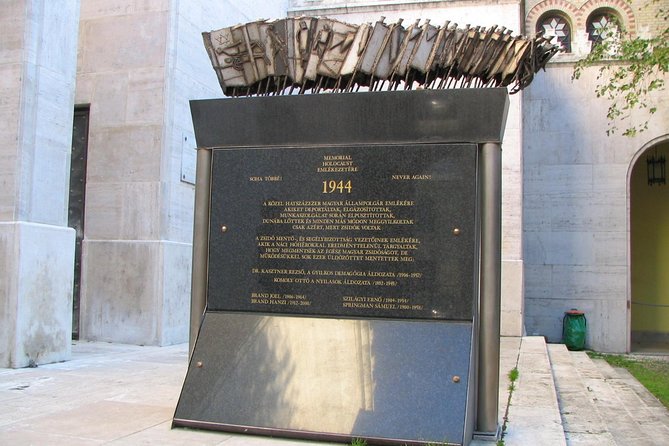
The Dohány Street Synagogue, situated in the heart of Budapest, stands as the largest Jewish temple in Europe and proudly houses the Hungarian Jewish Museum within its walls.
This magnificent edifice addresses the rich and complex history of Hungarian Jewry, including the devastating impact of the Holocaust.
Adorned with 1850s Hungarian architectural details, the synagogue offers visitors a glimpse into the country’s vibrant Jewish heritage.
As the centerpiece of Budapest’s Jewish Quarter, the Dohány Street Synagogue serves as a powerful reminder of the resilience and contributions of the Hungarian Jewish community, even in the face of unimaginable tragedy.
Ready for more culture? More museums we feature in Budapest
Architectural Details of the Synagogue
Intricate details from the 1850s adorn the Dohány Street Synagogue, showcasing Hungary’s vibrant architectural heritage.
Elaborate Hungarian designs can be seen throughout the synagogue’s interior and exterior, from the ornately carved wooden pulpit to the striking Moorish-style domes.
Visitors are captivated by the synagogue’s blend of Orientalist and Hungarian Romantic elements, which create a truly unique and visually stunning experience.
The synagogue’s façade features intricate carvings and decorative elements, while the interior boasts stunning stained-glass windows and ornate chandeliers.
Together, these architectural details transport visitors to a bygone era, offering a glimpse into Hungary’s rich cultural and religious history.
History of Hungarian Jewry

Beyond the synagogue’s architectural marvels lies the rich and complex history of Hungarian Jewry, which has endured periods of both prosperity and persecution over the centuries. Jews have inhabited the region of present-day Hungary since the 11th century, establishing vibrant communities that contributed significantly to the nation’s cultural, economic, and intellectual life. However, they also faced intermittent waves of antisemitism, culminating in the horrors of the Holocaust, where over 500,000 Hungarian Jews perished. The Dohány Street Synagogue stands as a poignant reminder of this tumultuous past, serving as a testament to the resilience and enduring spirit of the Hungarian Jewish community.
| Period | Experience |
|---|---|
| 11th Century | Jewish settlement in Hungary |
| 13th-15th Centuries | Economic and cultural prosperity |
| 19th-20th Centuries | Waves of antisemitism and persecution |
| 1944-1945 | Hungarian Holocaust, 500,000 deaths |
| Present Day | Continued preservation of Jewish heritage |
The Holocaust in Hungary
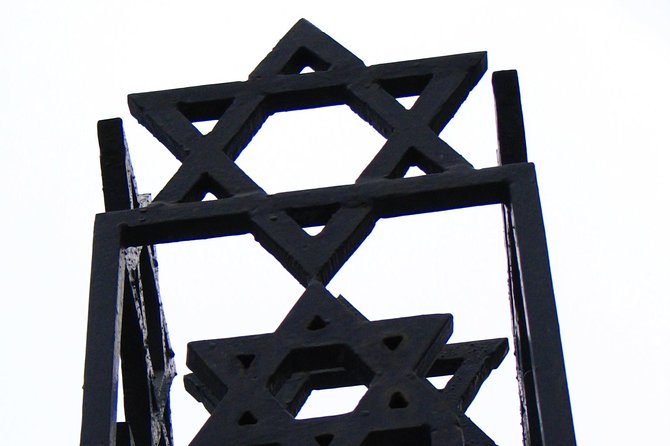
Tragically, the horrors of the Holocaust devastated the vibrant Hungarian Jewish community, resulting in the systematic genocide of over 500,000 individuals.
The synagogue’s exhibits and memorials powerfully depict this dark chapter, educating visitors about the atrocities committed. Key aspects include:
- The Holocaust Cemetery, where over 2,000 victims are laid to rest
- The Raoul Wallenberg Holocaust Memorial Park, honoring the Swedish diplomat who saved tens of thousands of Hungarian Jews
Poignant displays chronicling the persecution, deportation, and murder of Hungary’s Jewish population.
The synagogue’s role in providing shelter and aid to those fleeing Nazi terror during the 1944 Budapest Ghetto.
Museum and Exhibition Highlights
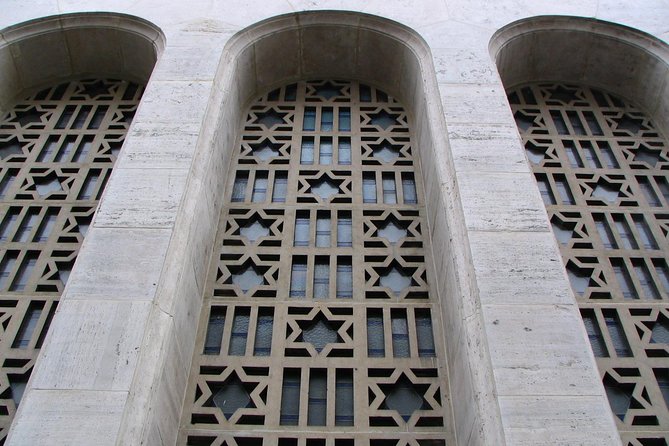
What makes the Hungarian Jewish Museum and exhibition at the Dohány Street Synagogue so captivating is its comprehensive exploration of Hungarian Jewish history, culture, and identity. The museum’s carefully curated displays explore the vibrant traditions, contributions, and challenges faced by this community over the centuries.
| Exhibition Highlights | Description |
|---|---|
| Holocaust Memorial | Commemorates the 600,000 Hungarian Jews killed during the Holocaust |
| Synagogue Treasures | Showcases ornate liturgical objects and historical artifacts |
| Interactive Exhibits | Bring the past to life through multimedia and hands-on experiences |
| Permanent Collection | Chronicles the story of Hungarian Jewry from medieval times to the present |
| Temporary Exhibits | Explore contemporary issues and artistic expressions of Jewish culture |
The museum’s thoughtful approach provides visitors with a profound understanding of this vibrant community’s enduring legacy.
- Budapest Danube Cruise With Buffet Dinner, Performances and Music
- Budapest Evening Sightseeing Cruise and Unlimited Proseccos
- Half-Day Wine Tasting Tour in Etyek Wine Country Near Budapest
- Budapest Danube River Candlelit Dinner Cruise With Live Music
- Guided Tours in Budapest on Monsteroller E-Scooter
- Budapest All in One Walking Tour With Strudel Stop
Visiting the Synagogue and Museum
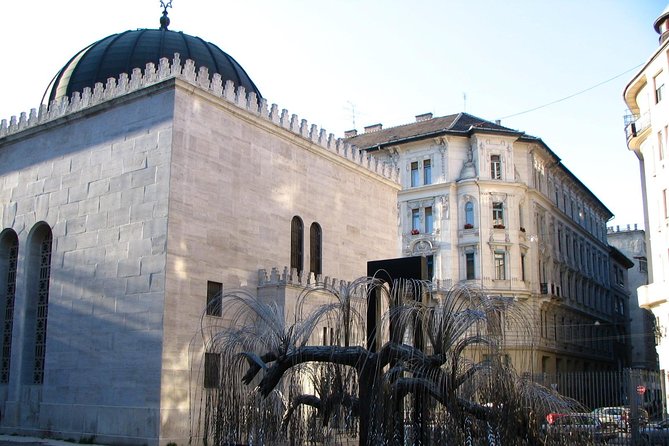
Visitors to the Dohány Street Synagogue can secure advance tickets to skip the lines and explore the grand architecture and rich history of this renowned Hungarian Jewish landmark.
The synagogue features stunning 1850s Hungarian details and serves as the home of the Hungarian Jewish Museum, which addresses the difficult legacy of the Holocaust in Hungary.
Visitors can:
- Marvel at the synagogue’s magnificent interior
- Learn about Hungarian Jewry through the museum’s exhibits
- Pay respects at the Holocaust Cemetery and Raoul Wallenberg Memorial Park
- Adhere to the modest dress code and pass through security measures
With advance tickets, travelers can enjoy this significant cultural experience at their own pace.
Dress Code and Security Measures

The synagogue’s modest dress code requires visitors to cover their shoulders and have legs covered down to the knee, with a cover available for purchase if needed.
Visitors must also pass through security checks, with large bags not permitted inside. This measure ensures the safety and respect for the sacred space.
Those with service animals are welcome, and the synagogue is accessible for wheelchair users and strollers.
With a maximum of 35 travelers, the experience provides an intimate setting to explore the rich history and architecture of this grand Hungarian Jewish landmark.
Advance ticket purchase is recommended to skip the lines and secure your entry to both the synagogue and museum.
Additional Practical Information
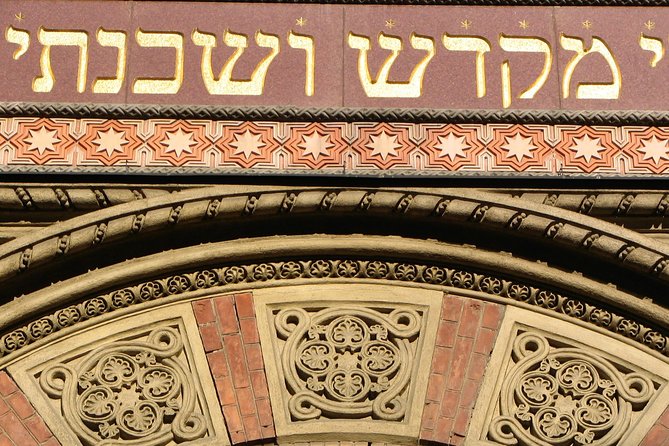
Confirmation of booking is received at the time of purchase, ensuring visitors have secured their entry to this renowned Hungarian landmark.
The synagogue and museum are wheelchair and stroller accessible, accommodating visitors with mobility needs. Service animals are also permitted on the premises.
Conveniently situated near public transportation options, the Dohany Street Synagogue and Hungarian Jewish Museum offer a seamless and accessible experience for all travelers.
Visitors can expect the following:
- Maximum group size of 35 travelers
- Secure access with mandatory security screening
- Complimentary dress code items available for purchase
- Guided tours with expert commentary on Hungarian Jewish history and the Holocaust
Frequently Asked Questions
What Is the Synagogue’s Opening and Closing Times?
The synagogue offers three daily entry times. Visitors can secure tickets in advance to skip the line and explore the historic site during these available times.
Are There Any Age Restrictions for Visitors?
There are no age restrictions for visitors. The synagogue and museum are open to all ages, though minors must be accompanied by an adult. Visitors should dress modestly, with shoulders and legs covered.
Can Photos Be Taken Inside the Synagogue?
Generally, photography is not allowed inside synagogues to preserve the sanctity of the space. Visitors should check with the staff on any specific rules or exceptions regarding photography during their visit.
Are Guided Tours Available in Multiple Languages?
Yes, guided tours of the synagogue and museum are available in multiple languages, including English, German, and others. Visitors can inquire about language options when purchasing their tickets.
What Are the Payment Options for Tickets?
Payment options for tickets generally include credit/debit cards and mobile wallets. Some venues may also accept cash. Advance online ticket purchases are recommended to skip ticket lines and secure entry.
Recap
The Dohány Street Synagogue is a must-visit destination that offers a profound exploration of Hungarian Jewish history and the devastating impacts of the Holocaust.
Its ornate architecture, permanent exhibitions, and interactive displays provide a comprehensive and impactful experience for all who seek to understand this complex and poignant story.
Visitors leave with a deeper appreciation for the resilience and legacy of the Hungarian Jewish community.
More Museum Experiences in Budapest
More Tour Reviews in Budapest
- Rudas Bistro Premium Brunch
- Budapest Buda Side Tour: Conquer the Castle
- Private Budapest Sightseeing Tour: Royal Castle, Heroes Square, Chain Bridge
- Private Transfer From Budapest to Split, Hotel-To-Hotel, English-Speaking Driver
- 7 Days Balkan Tour to Historic Croatia and Bosnia Herzegovina
- Explore Budapest Customisable City Game for Groups
Not for you? Here's more things to do in Budapest we have recnetly reviewed
- 2 Best Canoe And Kayak Experiences In Budapest
- 4 Best Craft Beer Tours And Tastings In Budapest
- 8 Best Christmas Experiences In Budapest
- 24 Best Dining Experiences In Budapest
- 20 Best Full-Day Tours In Budapest
- Best 3 Day Tours In Budapest
- 3 Best 4 Day Tours In Budapest
- 20 Best Massage And Relaxation Services In Budapest
- 20 Best Photography Experiences In Budapest
- 13 Best Coffee Tours And Tastings In Budapest
- 23 Best Dinner Tours In Budapest
- 25 Best Cruises And Boat Tours In Budapest
